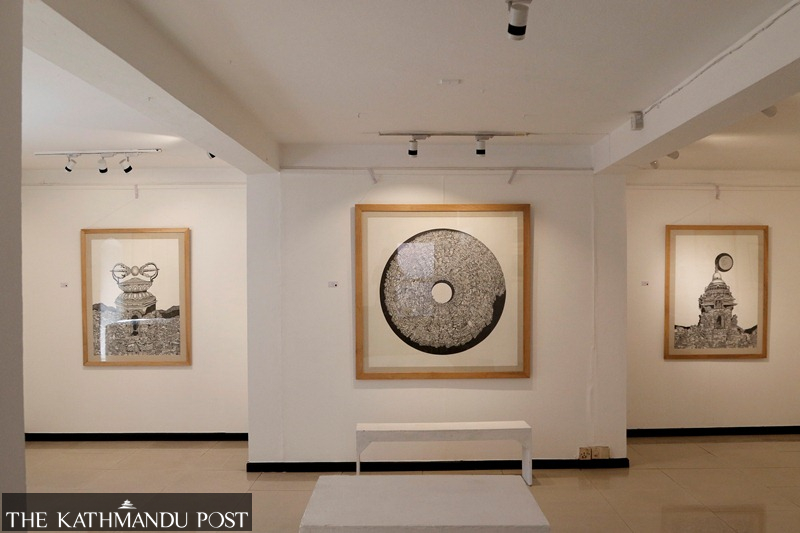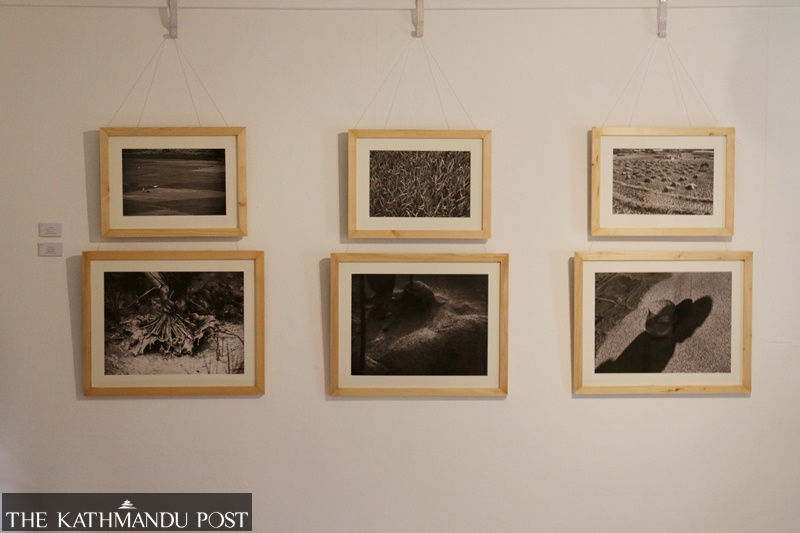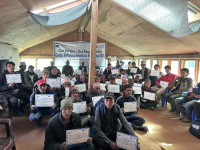Culture & Lifestyle
Art for conservation’s sake
The ongoing exhibition, ‘Tale of a city’, urges viewers to think critically beyond the white cube spaces of the exhibition and its artworks. But in its storytelling, it holds from giving too much information.
Shranup Tandukar
A huge pen-and-ink artwork hangs on the walls of Siddhartha Art Gallery. One feels drawn into the artwork as the kaleidoscopic portrayal of traditional Newa houses converges into the centre hole. One of the 26 artworks of Sujan Dangol, the ‘Lunatic city’ is rife with cultural references of the Newa community along with lunar symbolism.
The artwork is a part of the ongoing art exhibition titled ‘Tale of a city’ that opened at the end of October. The title itself is a misnomer as the art exhibition is not focused on a single city but different aspects of the Valley—seen from the perspectives of Newa culture and history. The direct reference to Newa culture and themes are missing from the exhibition description as well.
In the exhibition description of ‘Tale of a city’, the exhibition claims to be a collective outcome of the participating artists’ experiences of vibrant indigenous culture, tradition, and practices. The description goes on to further press for an urgent call to action for mindfulness with the daily choices for the preservation of heritage. The art themes subtly urge visitors to question the approach to the development seen in the Valley which has impacted age-old native heritages, culture, and tradition.
However, the approach to tackle these issues of development through shrewd and subtle themes is a debatable one. For an issue as grave as the loss of one’s culture, a more direct attitude identifying the faults and misconceptions might have been a better one. The exhibition fails to pinpoint the main argument it raises in that it tells a tale but it doesn’t tell enough for everyone to understand the concern it attempts to build. Not every visitor to the art gallery may read between the lines and understand the plea for mindful conservation about specific heritages and cultures as well as connect them with contemporary discourses about development.
Not everything needs to be spelt out but as one goes from art piece to art piece, one cannot help but realise the missed opportunity of giving sufficient keywords to make sense of the exhibition’s narrative.
The exhibition description, similar to the individual artwork descriptions and the artworks themselves, is guided with a minimalistic philosophy of information—to give only the prominent information about the artwork and its importance. The artworks placed in a white cube gallery—with only visual information at the forefront—urge visitors to thematically connect one artwork with another. Only at the opening ceremony of the art exhibition did it include a more holistic approach—with traditional music, Khyaa dance performances, and Samay Baji feast. Visitors to the exhibition who didn’t attend the opening ceremony also missed the performance of ‘Jattadhari Bhajan Khala’, a traditional Newa musical ensemble.

The art exhibition is divided into two floors: on the ground floor, there are artworks by Film Foundry, Sujan Dangol, and Sharmila Shrestha while the first floor displays artworks by Ashish Dangol, Sujan Dangol, and Anil Ranjit. After the exhibition description, the first artwork that catches one’s eye is the collection of nine silver gelatin prints by Film Foundry. The photographs are mostly of Khokana where the art series description reads, “The cultural and religious practices are different from the rest of the Newa community of the Valley. Unlike the others, they don’t worship idols. They use symbols.”
The prints themselves are highly intriguing: sepia-filter-like images of glimpses of rituals, old people, and chariots being built are marked by revered symbols in vermillion. A collective artwork of three members—Abhishek Shah, Jagadish Upadhyay, and Rupesh Man Singh—of Film Foundry, the artworks aren’t printed on any common digital print paper but on ‘Nepali kagaj’. The whole process of turning ‘Nepali kagaj’ into a material strong enough to handle image printing and also the archival process is delved into some detail in the artwork description.
Though the symbols and the images themselves are fascinating, the artworks emphasise more on the process of chemically preparing the paper. The meaning of the symbols and their mysticism stays enshrouded in ambiguity and one wonders if the symbols are a sort of relics from cave-painting eras of humankind.
Visitors are encouraged to engage in an active and critical thought-process inside the gallery—to see beyond the artworks and its theme and into the real-life implications of the harmful apathy and wrongful preservation approaches to jatras, religious symbols, culture, heritage, and the tradition of perhaps different indigenous communities. In this way, the artwork aims to manifest beyond its physical boundaries; to break out of the confines of paper, digital print, and new media inside glass and connect with visitors’ empathy.
On the ground floor, there are a total of eight artworks by Sujan. The striking motif in his artworks—that he points out in his artwork description, as an illustration, to “evoke a sense of loss”—are old Newa architecture and cultural heritage of the Valley. In some of his artwork, the sky is covered in a series of intricate patterns which adds a sense of depth to the pictures: Looking at the picture it’s as if you are being dragged into the centre of the intricate patterns. The intricate patterns along with the countless miniature traditional Newa houses with an occasional temple or stupa against a backdrop of a dark hillside evoke a strong sense of the Valley with its rich Newa culture and tradition. The artworks literally and figuratively pull and command one’s attention.
In Sujan’s artworks, the motif of traditional Newa architectures upholding prominent cultural heritages—such as temple, stupa, and bajra among others—underlies a sense of apathy towards less commercial heritages. Popular cultural heritages which act as tourist hubs are preserved with local, community, and government efforts; however, common cultural heritages like traditional old Newa houses and lesser-known monuments receive less attention. Such themes are hidden between the lines and behind conversations with the artists themselves.
To call Sujan’s artworks the centrepiece of the exhibition would not be amiss, however, his artworks claim that title at the cost of other artworks, eclipsing them somewhat in the process. The sheer size and number of his artworks outnumber other artworks. The themes and motifs of his artwork—be it countless traditional Newa architecture, lunar symbolism, blackened valley backgrounds or sukul-inspired intricate patterns—conspicuously uphold the sense of loss in comparison to other artworks.
However, the other artworks are not trivial by any means—Sharmila Shrestha’s new media artwork is a particularly fascinating piece that combines the artist’s personal journey towards her artistic roots with the wider societal concerns. Her art pieces feature either square-shaped or circle-shaped sukul (a mat made up of rice straws common in Newa households or localities) with different seeds on top of them to create different designs. Her artworks consist of nine different pieces and each one contains a distinct seed pattern.
Her art piece reinstates how the Valley, once known for its lush fields and rich soils, now has turned into a concrete jungle and how farming—along with the reverence of seeds—which used to be a universal way of life has all but disappeared. Her admonition of greed and ego in her artwork description relays how we have venerated short-term visions of modernity in lieu of long-term preservation of cultural heritage.

Shrestha’s artwork connects thematically best with Anil Ranjit’s collection of six digital prints of agrarian tales of Swaniga, one of the original names of Kathmandu valley in Nepalbhasa. While Shrestha focuses on the micro-level of the agrarian society with her focus on seeds, Ranjit combines both the micro and macro level. From the grains to the swatches of straw bundles to muddy and fertile soil, the gorgeous digital prints pay homage to the bustling agrarian society universal to the Valley at large.
However, the artworks merge motifs of Newa culture with themes of loss which may only be relevant to visitors well-versed in Newa culture and history. Sukuls have become less common in Newa households and localities, much like signs of agriculture in the Valley.
In another example, Ashish Dangol has captured the essence of ‘Sikali Jatra’ in his eight digital print pieces. The jatra is one of the main festivals for the residents of Khokhana and is also prioritised over Dashain. But Dangol’s prints, although picturesque, do not offer a new and deeper perspective on the festival.
Beneath the call for the preservation of ‘our festival, our identity, and our legacy’ lies the controversial web of tension between Khokana residents and the government over developmental projects such as the Kathmandu-Tarai Expressway, the Outer Ring Road Development Project, and a high-tension power line among others. These developmental projects will encroach numerous cultural heritage sites as well as the site of Sikali Jatra. Sujan wrote in his artwork description that “without action, language may survive but it may also be the only heirloom that Newars [sic] bequeath down the generations.” In the same vein, through the digital prints of Sikali Jatra, Ashish subtly conveys how without action, only photographs as remnants may survive in the name of development.
Looking at the artworks of ‘Tale of a city’, every artwork portrays a deep sense of respect and reverence towards indigenous culture and traditions. However, the individually beautiful artworks do not voice a collective story. The exhibition fails in its intention to “help create a shared narrative that stretches beyond all borders.”
Regardless, the exhibition is an important one that is worth a visit as it raises essential issues about our notion of development and disregard towards cultural heritages in the Valley.
‘Tale of a city’ will be displayed until November 29 at Siddhartha Art Gallery, Baber Mahal Revisited.




 8.12°C Kathmandu
8.12°C Kathmandu















